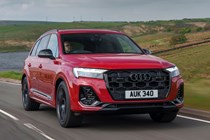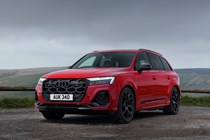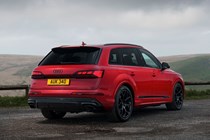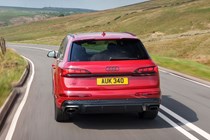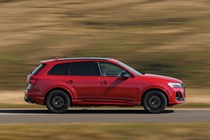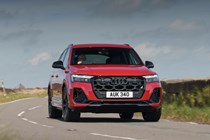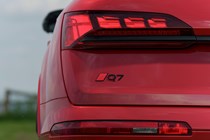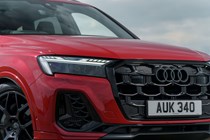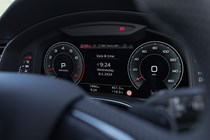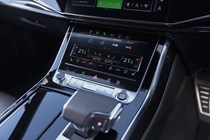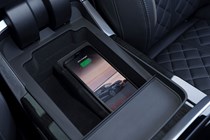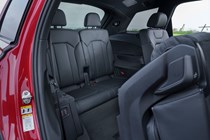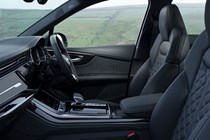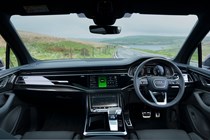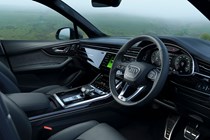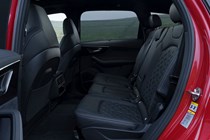Audi Q7 engines, drive and performance
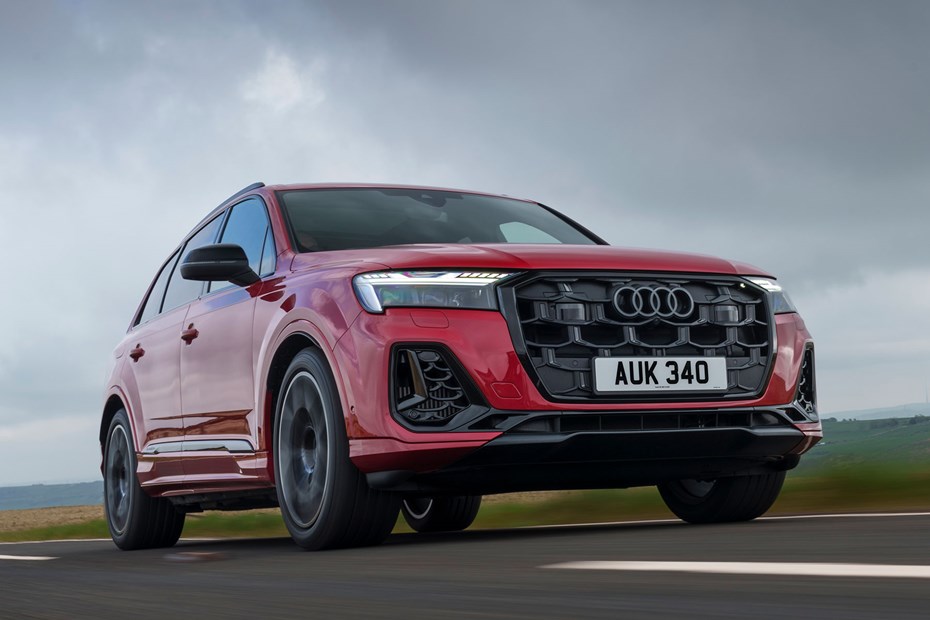
- All engines provide impressive performance
- Monster SQ7 as quick as many sports cars
- Diesel engines probably make the most sense
Petrol engines
There are now just two petrol engines to choose from. The 55 TFSI has a turbocharged 3.0-litre V6 with 340hp and 500Nm of torque, which Audi says is enough for a 0–62mph time of 5.6 seconds and a top speed of 155mph. It’s certainly quick, with enough mid-range punch for overtaking on the motorway. You do need to work it quite hard to get the best from it, though. And in a car as big and heavy as this, that’s ruinous for your fuel economy.

Above the 55 is the SQ7. It has turbocharged 4.0-litre V8 with a monstrous 507hp and 770Nm of torque. It’s a bit of a sports car slayer, with a 0–62mph time 4.1 seconds and enough power in the mid range to punt your noggin into the headrests. Surprisingly, we also found it to be a little more efficient. We averaged just over 20mpg in the V6, but around 28mpg in the V8 simply because we didn’t need to hammer it as often. You can learn more about the SQ7 in our dedicated review.
Diesel engines
Kicking off the line-up is the 45 TDI. It’s a 3.0-litre V6 diesel with 231hp and a healthy 500Nm of torque. Audi says it takes this engine 7.1 seconds to get the Q7 from 0–62mph before topping out at 142mph.
But the more powerful version of the same engine has long been a better fit for the Q7. It’s called the 50 TDI and it has a much more sprightly 286hp and 600Nm of torque. That trims the car’s 0–62mph time down to 6.1 seconds and punches its top speed up to 150mph. And while it’s quiet and refined, it also sounds great.
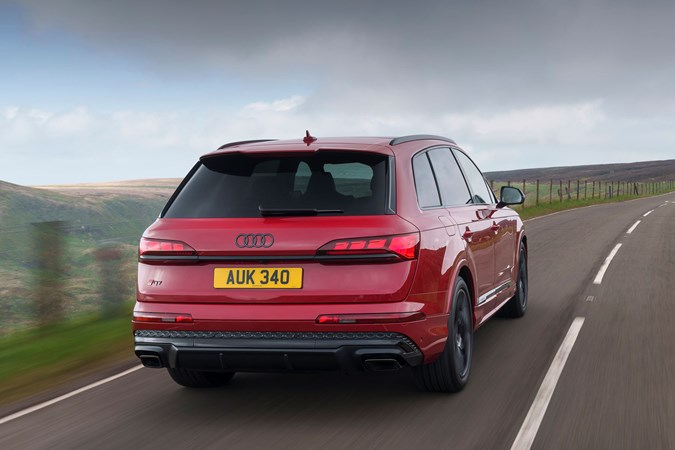
It performs a little oddly, as the eight-speed automatic gearbox affects the power delivery. It can sometimes catch you out if you demand it to kick down and pick up speed. Selecting the sharper Dynamic driving mode improves the situation, thanks to its faster throttle and gearbox responses, but you’ll also need to plan your timing when stationary at junctions and roundabouts. A heavy application of the accelerator pedal generally leaves you stationary for a brief moment, before gearbox releases the engine’s power in one lump.
It feels a little uncouth and, as a result, the Q7 is best experienced when you’re using the mountain of torque from to pull you along rather than screaming the engine out to the redline. There’s plenty of muscle available, but it can become a little flustered when you ask the engine and gearbox to work hard.
Plug-in hybrid powertrain
The plug-in hybrid system blends an electric motor with a 3.0-litre petrol engine to produce 381hp. It’s able to run on electric power alone for up to 34 miles (according to official figures), and it delivers maximum torque output of 600Nm. This makes for a 0–62mph sprint in just 5.8 seconds if you floor the throttle; performance that feels otherworldly in a car of these dimensions, especially thanks to the instant electric shove from the motors. Top speed is 149mph.
What’s it like to drive?
- Q7 handles its bulk very well indeed
- Adaptive air suspension is standard
- Great balance between comfort and handling
Considering the Q7 is a big, heavy SUV, it handles very well indeed. This is thanks to Audi’s excellent adaptive air suspension, which manages to be comfortable when you’re cruising down the motorway and sharp once you turn onto the A-roads.
We’ll start with the motorway, because that’s where this car is most at home. The Q7 is an old car, now – and there’s a distinctly old fashioned quality to the way it rides. It breathes with the road, its suspension working with the cambers and the lumps rather than trying to batter them into submission. It’s superb.
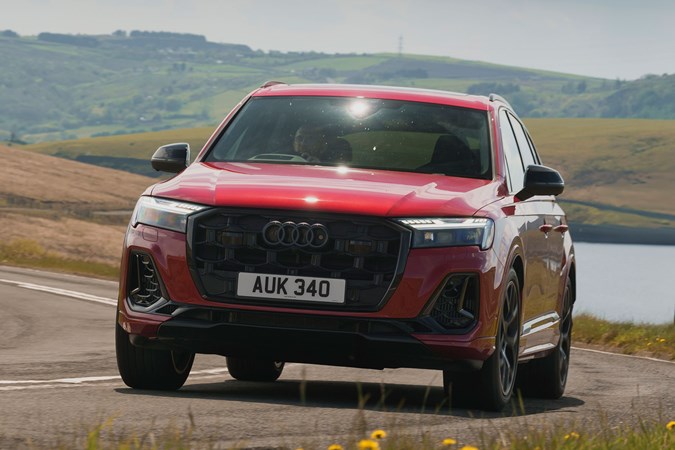
A word of warning, though. We’d recommend you avoid the biggest 22-inch alloys if you can. The suspension can cope fine with the 21s, but that missing inch of sidewall adds a surprising amount of harshness to the experience, especially with the car programmed into its firmest Dynamic mode. It’s just too fidgety.
Another old school thing that we love about the Q7 is its steering. Good grief, it’s marvellous. It’s well-weighted, direct and offers enough feedback to let you know what’s happening at the front wheels. That’s rare in a modern car, even from BMW’s ‘Ultimate Driving Machines.’
Audi’s rear-wheel steering system is sorcerous, too. At low speeds, it makes the Q7 feel far smaller than it is by turning the rear wheels in the opposite direct to the fronts (like a forklift). That cuts the SUVs turning circle by a whole metre, which is the difference between fitting the car in a multi-storey car park and going home.
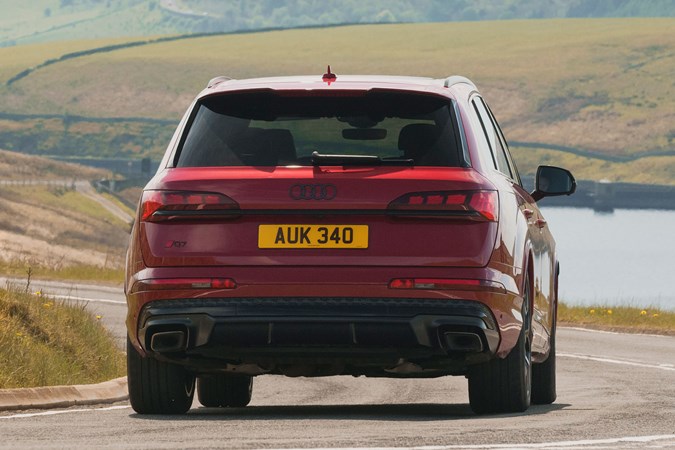
At higher speeds, it turns the rear wheels in the opposite direct to the fronts. That means the car almost crabs between lanes on the motorway with barely any input at the steering wheel – and that means your passengers don’t the G-forces as severely. Pure class.
It’s a little out of its depth on a B-road. That’s not because the damping or four-wheel drive system can’t handle it, though. It’s just because the car’s sheer dimensions count against it, so you never have the confidence to really hustle it. You’re always afraid that a tractor or a van is going to come the other way and the resulting accident is going to let off enough energy to level a town.


